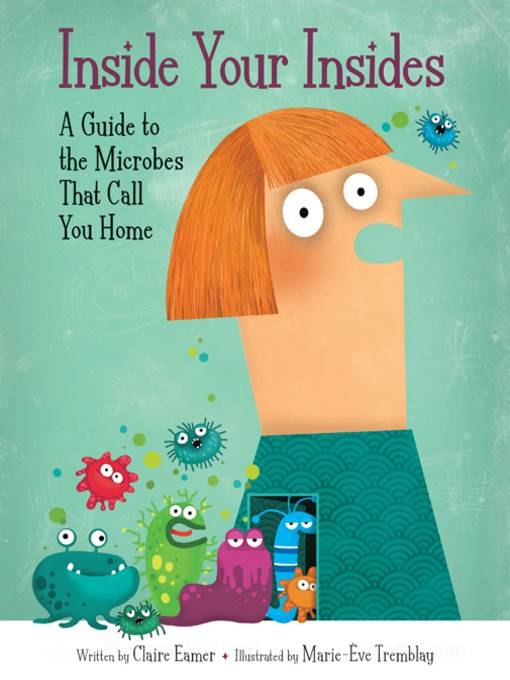
Inside Your Insides
A Guide to the Microbes That Call You Home
راهنمایی درباره میکروب هایی که جسم شما را خانه خود میدانند
فرمت کتاب
ebook
تاریخ انتشار
2016
Lexile Score
1010
Reading Level
6-8
نویسنده
Marie-Ève Tremblayناشر
Kids Can Press Ltd.شابک
9781771387545
کتاب های مرتبط
- اطلاعات
- نقد و بررسی
- دیدگاه کاربران
نقد و بررسی

June 15, 2016
A breezy text and comic illustrations introduce middle-grade readers to their microbiomes--the trillions of microbes that live in them and on them.The author of A World in Your Lunch Box (illustrated by Sa Boothroyd, 2012) turns her attention to the world of our own human bodies, making the point that microbes, the tiniest of living things--bacteria, archaea, viruses, fungi, protists, and mites--are vitally important in our lives. Topic by topic, one per double-page spread, Eamer introduces these microscopic "hitchhikers," describes their discovery, our "war" against them, and our subsequent realization that the majority are harmless and even beneficial. She goes on to present both harmful and helpful unseen inhabitants of our skin, lungs, mouth, gut, and even poop. And she goes into a little more detail about the human fight against bad bacteria and how bacteria have fought back by evolving. A final chapter describes ways young readers can attract a variety of different microbes to their personal microbiomes and then care for them. Sidebars feature a cartoon bacterium with a fondness for punny jokes and a series of "Did You Know?" factoids (and one urban legend). The unsourced text is lighthearted but briskly informative, and it has a considerable "eeuww!" factor. The jazzy design and plentiful, brightly colored illustrations add appeal. Solid information presented in a sprightly manner that's sure to appeal. (glossary, index) (Nonfiction. 8-12)
COPYRIGHT(2016) Kirkus Reviews, ALL RIGHTS RESERVED.

Starred review from July 1, 2016
Gr 3-6-For readers who are curious about the trillions of microbes they carry around inside and outside their body, this book provides clear information in a friendly, amusing style that is a blast to read. ("Where will you find your collection of microbes? Everywhere! They're inside and outside of you, in your nose and mouth, in your lungs, between your toes, in your hair and eyelashes, and snuggled in the warm hollow behind your ears.") The text, which is divided into spreads, is very easy to navigate. Among the topics covered are the common types of microbes, the importance of microbes to our well-being, why it doesn't make sense to wage war against all microbes, and the work of researchers past and present that contributes to our understanding of them. Each spread consists of a title, written text accompanied by illustrations that are sometimes humorous and sometimes strictly informative, jokes, and a "Did You Know?" sidebar feature that adds humor and additional content. A great deal of science vocabulary is skillfully introduced. A concluding spread provides advice about how to keep your microbiome happy and discusses current research aimed at maintaining a healthy microbiome and even fixing one that has gone wrong. This book is a winning mix of scientific information, humor, and fascinating facts. VERDICT An excellent example of engaging science writing, this title would be a useful mentor text for young science writers and a fine addition to science programs dealing with the topic of the human body.-Myra Zarnowski, City University of New York
Copyright 2016 School Library Journal, LLC Used with permission.

July 1, 2016
Grades 3-5 This upbeat book encourages kids to consider their bodies as microbiomes by pointing out that everyone carries tiny hitchhikers, microbes living in and on the human body. After introducing common varieties such as bacteria, archaea, viruses, fungi, protists, and mites, Eamer discusses Earth's invisible sea of microbes, which enables the existence of more complex life-forms. One two-page spread focuses on microbial bad guys that cause problems from bad breath and dandruff to diseases such as colds, malaria, and plague, and the next spotlights the good guys, such as those that help with digestion of food and breaking down waste materials. Each large spread carries a good bit of information in both the main text and Did You Know? sidebars, while colorful illustrations of people and cartoonlike microbes keep the pages looking bright and inviting. Shedding light on common misunderstandings about microbes, this clearly written, informative book offers a good introduction to their roles in the human body and a possible antidote to germ phobia.(Reprinted with permission of Booklist, copyright 2016, American Library Association.)

























دیدگاه کاربران